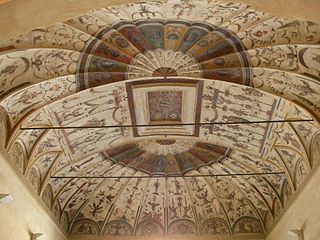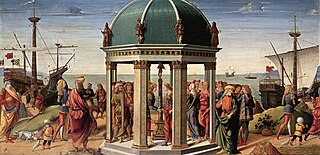Ferraù Fenzoni was an Italian painter mainly active in Todi working in a style situated between Mannerism and Baroque. He is also called Il Faenzone after his birthplace (Faenza).
Lamberto Zauli is the Italian association football coach and former player who spent his career playing as an attacking midfielder, but was also capable of playing on the left wing on occasion.
Felice Giani was an Italian painter of the Neoclassic style. His grand manner subjects often included Greco-Roman allusions or themes.
Vittorio Bigari was an Italian painter of the late-Baroque period.
Tommaso Misciroli (1636–1699) was an Italian painter of the Baroque period. Also called il Pittor Villano or the Peasant Painter. Born in Faenza. He studied the work of Guido Reni. In Faenza, he painted a Martyrdom of Saint Cecilia for the church of namesake in Faenza.

Marco Marchetti was an Italian painter of the late-Renaissance or Mannerist period. Born in Faenza, he is also known as Marco da Faenza. He painted an Adoration by the shepherds (1567) originally in the church of the confraternity of Santa Maria dell'Angelo, but now in the pinacoteca of Faenza. He also painted along with Giorgio Vasari a series of frescoes in the Palazzo Vecchio representing the Life of Hercules. He painted an altarpiece representing the Martyrdom of St. Catherine of Alexandria (1580) in the church of Sant'Antonio in Faenza.

Biagio d’Antonio Tucci was an Italian Renaissance painter whose style was influenced by Filippo Lippi, Andrea Verrocchio and Domenico Ghirlandaio.

Francesco da Cotignola, also called Zaganelli, was an Italian painter of the Renaissance period, active mainly in Parma and Ravenna.
Sigismondo Foschi, also called Sigismondo da Faenza was and Italian painter of the Renaissance period, born and active in Faenza. He was likely a pupil of Giovanni Antonio Sogliani. As a young man, in 1520, he assisted his father in completing an altarpiece in a chapel in San Francesco in Faenza. Sigismondo’s father, Antonio, was a gold and silversmith. Sigismondo painted an Assumption of the Virgin (1522) for the church of Santa Maria della Terra at Solarolo. He painted a Madonna and child with saints (1527) for the church of San Bartolomeo in Faenza. Other sundry works are assigned to the painter without definitive attribution. An altarpiece of Madonna and child with Saints Paul, John the Baptist, Benedict (?), Sebastian, Catherine and Apollonia, originally from the church of Santa Maria ad Nives, is found in the Pinacoteca of Faenza. Documents establish that he died by 1536.

Tommaso Minardi was an Italian painter and author on art theory, active in Faenza, Rome, Perugia, and other towns. He painted in styles that transitioned from Neoclassicism to Romanticism.
Giovanni Piancastelli was an Italian painter and architect.
Nicola Levoli was an Italian painter and an Augustinian monk. His name prior to becoming a monk was Remigio Enrico Policarpo.

Antonio Berti was an Italian painter, mainly portraits, landscapes, and romantic scenes.

Giuseppe Marri (1788–1852) was an Italian engraver.
Niccolò Paganelli was an Italian painter of the late-Renaissance period.
Tommaso Dal Pozzo, also known as Tomaso Dalpozzo was an Italian painter and ceramist, mainly depicting landscapes and genre scenes.
Zauli is an Italian surname. Notable people with the surname include:
The Premio Faenza is an international prize for contemporary ceramic art. It is awarded by the Museo Internazionale delle Ceramiche in Faenza, in Emilia-Romagna in northern Italy, and is the principal Italian prize of its kind.







